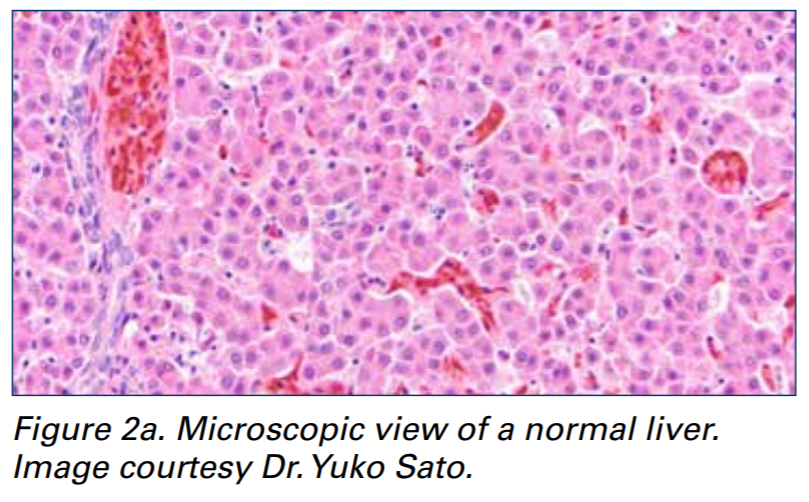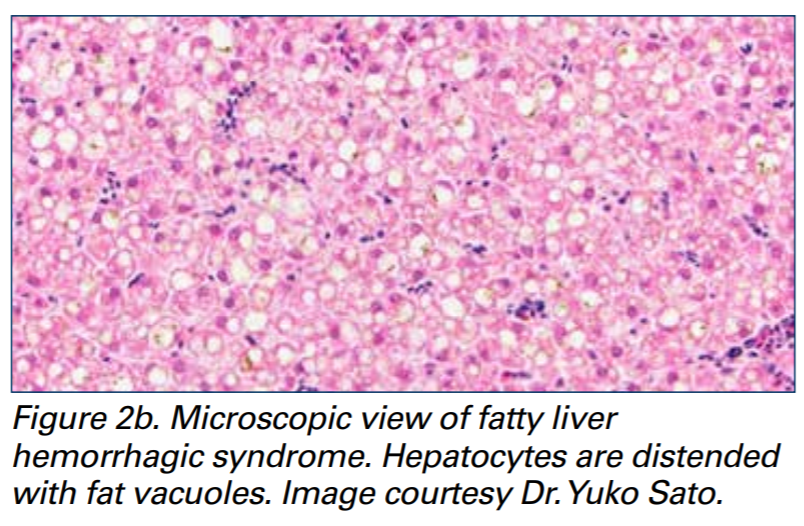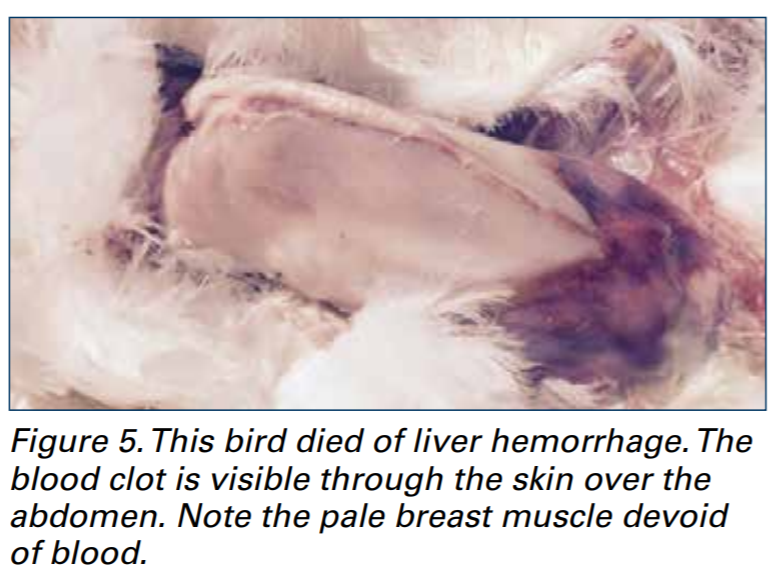



Fatty liver haemorrhagic syndrome
Fatty liver haemorrhagic syndrome (FLHS) is a noninfectious disease characterised by excessive accumulation of fat in the liver and abdominal cavity, causing liver rupture, haemorrhage and sudden death of hens1. Death is the result of internal bleeding.

FLHS occurs most commonly in egg-type layers in confinement cage housing. Affected flocks can experience significant economic losses from both bird mortality and decreased egg production2. In an epidemiologic survey, 40 percent of caged hen mortality was associated with FLHS. The same survey showed that FLHS can occur in cage-free housing systems, but at a lower rate than in cage systems. Total mortality due to fatty liver usually does not exceed 5 percent.
Pathology
Hens in affected flocks are generally obese (overweight by 20 percent or more) and experience a sudden drop in egg production3. Dead birds often have a pale head, wattles, comb or skin. Necropsy reveals livers that are enlarged, pale, soft and engorged with fat. The excess fat in the livers makes them yellow, sort, and friable. The affected liver has lost structural integrity leading to a susceptibility for rupture and haemorrhage. The liver may easily break apart when handled. Large blood clots are found within the abdomen. The origin of the blood clot is from a rupture of the liver capsule. In other instances, the liver is yellow, greasy and soft. There are generally abundant abdominal and intestinal (mesenteric) fat reserves present.

Histopathology
Microscopic examination of liver tissue shows liver cells (hepatocytes) that are grossly distended with fat. There may be haemorrhages present. Fat within the hepatocytes are seen as clear spaces (vacuoles) within the cytoplasm of the hepatocytes4,5,6. The accumulation of fat within the liver weakens the integrity of blood vessels, leading to haemorrhage7.

Egg shell quality
There is an association between FLHS and poor egg shell quality8. One important function of the liver is the activation of Vitamin D into its metabolically active form. Serum calcium levels in hens with FLHS are elevated, suggesting interference with the formation of active Vitamin D (1, 25, (OH2) D3) which is vital in egg shell formation process9.
Possible causes of FLHS
The exact cause of FLHS is unclear. Factors related to nutrition, genetics, environment and hormonal influences have been proposed. It is suspected that a combination of these factors is needed to cause FLHS2, 10, 11.
Body weight and energy balance
Dietary energy consumed in excess of what is required is processed by the liver and stored as body fat. This occurs regardless of source energy (ie fat vs carbohydrate)5. When excess energy is available for fay synthesis by the liver of an extended period of time, obesity and increased fat infiltration of the liver occur17.

FLHS was first recognised after high energy density diets were introduced to the layer industry. These diets, especially those with a maize or wheat base, have been associated with higher incidences of FLHS12, 14, 15. Layers housed in cages are less active than those in other housing systems; therefore, they have lower maintenance energy requirements, and are at a higher risk for receiving excess energy7, 16.
Oestrogen predisposes the flock to FLHS
The hormone oestrogen is associated with sexual maturity and stimulates the liver to store more fat of egg yolk synthesis. When the bird comes into eff production, the liver size increases dramatically in response to oestrogen levels. A combination of positive energy balance and influence of oestrogen predisposes the laying bird to develop FLHS. This emphasises the need to avoid excess energy intake, especially in the early laying period when birds are in a highly productive state.
Heat Stress
The highest incidences of FLHS occurs during warm periods. Higher environmental temperatures reduce energy requirements, leading to a more positive energy balance19, 20, 21. Birds rely on evaporative cooling during respiration to regulate body temperature. Increased abdominal fat from excess energy can interfere with normal breathing and cooling, making these birds more prone to both heat stroke and liver rupture.

Mycotoxins
Mycotoxins, especially aflatoxins, which may contaminate cereals, induce liver lipid accumulation22 and liver haemorrhages. The use of rapeseed meal in diet increases the incidence of FLHS, because eurcic acid or other toxic metabolites can affect the strength of the connective tissue in the liver23, 24, leading to hepatic cell breakdown and haemorrhaging.
Prevention strategies
Feed adequate energy to sustain the birds and optimise production, but not more. Maximising energy intake in the early period of lay is essential to support productivity; however, energy requirements will decrease through lay as production decreases. It may be necessary to reduce diet density to avoid birds gaining excess weight. Limit energy intake through the use of a lower energy diet and/or changing feed management.
Replacing dietary carbohydrates with supplemental fat has been shown to reduce the incidence of FLHS as long as the energy level of the diet is not increased13. Supplemental fat depresses synthesis of new fatty acids, so the liver has to produce less fat for the yolk. This reduces the metabolic burden on the liver.
Use of crumbled or pelleted feed results in greater feed and energy intake than mash feed. Avoid crumb and pellets in flocks susceptible to FLHS.
Layer diets should contain adequate levels of Vitamin E (50-100kg) and selenium (0.3ppm) to ensure adequate levels of antioxidants to prevent tissue rancidity26. Supplementation with lipotropic agents** such as chlorine (500mg/kg), methionine (0.1 percent) and Vitamin B12 help to metabolise fat from the liver, and support recovery in affected hens.

Calcium deficiency has been associated with FLHS. This can be addressed with the addition of large-particle calcium and Vitamin D to the ration. This allows the bird to eat more calcium without over-consuming the energy component of the feed.
Avoid any form of stress. Heat stress is a particular concern as it can precipitate or accentuate the occurrence of FLHS5.
One of the most important aspects of FLHS prevention is monitoring for risk factors and signs10, 11. Feed intake should be monitored, along with increases in body weights and mortality and decreases in egg production. Routine (at least every 30 days) body weight and uniformity checks can help reveal development of excess body weight. Less uniform flocks are more likely to contain relatively heavier birds with a greater risk of FLHS. Perform post-mortem examinations of mortality to assess the condition of the liver, and be alert to excess abdominal fat.
**Lipotropic nutrients
Lipotropic nutrients are feed ingredients that promote healthy liver function and the export of fat from the liver. Methionine, chlorine, insitol, Vitamin B12, biotin, L-trytophan, carnitine and selenium are essential for proper liver function and fat metabolism. Supplementation of these nutrients in the diet or in birds' drinking water has been used as a treatment for FLHS with variable success.
References
1. Crespo, R., and H.L. Shivaprasad. 2003. Development, metabolic and other non infectious disorders. pp 1048-1102 in Diseases of Poultry. 11th ed. Y.M. Saif, H.J. Barnes, J.R. Glisson, A. M. Fadley, L.R. McDougald, and D. E. Swayne, ed. Iowa State University Press, Ames.
2. Squires and Leeson, 1988 Squires, E. J. and S. Leeson,1988. Aetiology of fatty liver syndrome in laying hens. Br. Vet. J. 144:602-609
3. Dinev, I. 2010. Fatty Liver Haemorrhagic Syndrome in ‘Diseases of Poultry’ A Colour Atlas.
4. Pearson, A.W. and E.J. Butler, 1978a. Pathological and biochemical observations on subclinical cases of fatty liver hemorrhagic syndrome in the fowl. Res. Vet. Sci. 24:65-71.
5. Leeson, S and J.D. Summers, 1995: Poultry Metabolic Disorders and Mycotoxins; Fatty liver hemorrhagic syndrome pp. 64.
6. Trott, K.A., F. Giannitti, G. Rimoldi, A. Hill, L. Woods, B. Barr, M. Anderson and Mete A., 2014. Fatty liver hemorrhagic syndrome in the backyard chicken: A retrospective histopathologic case series. Veterinary Pathology. Vol. 51(4) 787-795.
7. Butler, E.J. 1976. Fatty liver diseases in the domestic fowl. A review. Avian Path. 5:1-14.
8. Harms, R.H. and C.F. Simpson, 1979. Serum and body characteristics of laying hens with fatty liver syndrome. Poult. Sci. 58: 1644-1648.
9. Miles, R. D., R. H. Harms and Junqeira O. M., 1985. Plasma calcium, phosphorus, 25-dihydroxy vitamin D3, and 1-25-dihydroxyvitamin D3 of hens with fatty liver syndrome. Poult Sci Apr, 64(4):768-70
10. Julian, R.J., 2005. Production and growth related disorders and other metabolic diseases of poultry – A review. The Veterinary Journal 169, 350-369.
11. Leeson, S., 2007. Metabolic challenges: past, present and future. The Journal of Applied Poultry Research 16:121-125.
12. Couch, J.R., 1956. Fatty liver in laying hens – a condition which may occur as a result of increased strain. Feedstuffs. 28: 46-54.
13. Haghigi-Rad, F. and D. Polin, 1982b. Lipid alleviates fatty liver hemorrhagic syndrome. Poult. Sci. 61:2465-2472.
14. Pearson, A.W., A.V. Arkhipou, E.J. Butler and LauresenJones A.P., 1978. Influence of dietary cereal and energy content on the accumulation of lipids in the liver in fatty liver hemorrhagic syndrome in the fowl. Res. Vet. Sci. 24:72-76.
15. Polin, D. and J.H. Wolford, 1976. Role of estrogen as a cause of fatty liver hemorrhagic syndrome. J. Nutr. 107:873-886.
16. Akiba, Y., Jenson, L.S., Barb, C.R. and Kraeling, R.R., 1982. Plasma estradiol, thyroid hormones and liver lipid content in laying hens fed different isocaloric diets. J Nutr. 112: 299-308
17. Shini, A., 2014. Fatty liver haemorrhagic syndrome in laying hens: Field and experimental investigations. PhD thesis University of Queensland School of Agriculture and Food Sciences.
18. Polin, D and J. H. Wolford, 1977. The Role of Estrogen as a cause of fatty liver hemorrhagic syndrome. J Nutr. 107(5): 873-886
19. Ivy, C.A., and Neisham, M.C. (1973). Factors influencing the liver fat content of laying hens. Poultry Science, 46:872-881.
20. Akiba, Y., Takahashi, K., Kimura, M., Hirama, S. and Matsumoto, T., 1983. The influence of environmental temperature, thyroid status and a synthetic estrogen on the induction of fatty livers in chicks. Br Poult Sci. 24:71-80.
21. Jensen, L.S., C.H. Chang and R.D. Wyatt, 1976b. Influence of carbohydrate source on liver fat accumulation in hens. Poult. Sci. 55:700-709
22. Bryden, W.L., Cumming, R.B., Balnave, D., 1979. The influence of vitamin A status on the response of chickens to aflatoxin B1 and changes in the liver metabolism associated with aflatoxicosis. Br J Nutr. 41:529-540.
23. Bhatnagar, M.K., Yamashiro, S., David, L.L., 1980. Ultrastructural study of liver fibrosis in turkeys fed diets containing rapeseed meal. Res Vet Sci 29: 260-265.
24. Martland et al., 1984 Martland, M.F., Butler, E.J and Fenwick, G.R., 1984. Rapeseed induced liver haemorrhage, reticulolysis and biochemical changes in laying hens: the effects of feeding high and low glucosinolate meals. Res Vet Sci. 36: 298-309.
25. Hazel, K., 2009: Hepatic lipidosis: Is Carnitine deficiency the underlying cause? In: Turkey production: Towards better Welfare and Health. Proceedings of the 5th International Meeting of the Working Group 10 (Turkey) of WPSA (ED. Hafez, H.M), Berlin. Mensch&Buch Verlag.
26. Maurice, D.V., L.S. Jensen and Hikeaki Tojo., 1979; Comparison of Fish Meal and Soybean Meal in the Prevention of Fatty Liver-Hemorrhagic Syndrome in Caged Layers. Poult Sci. 58 (4): 864-870.








